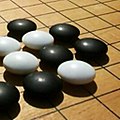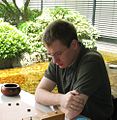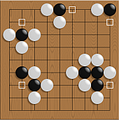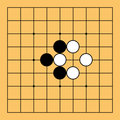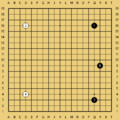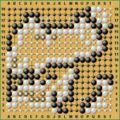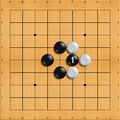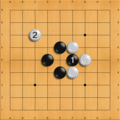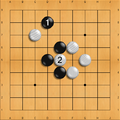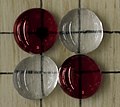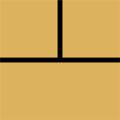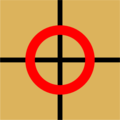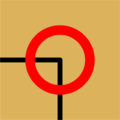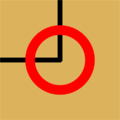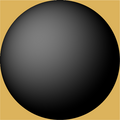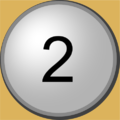Go (board game)
Jump to navigation
Jump to search
board game for two players that originated in China more than 2,500 years ago | |||||
| Upload media | |||||
| Instance of | |||||
|---|---|---|---|---|---|
| Subclass of |
| ||||
| Part of | |||||
| Inception | |||||
| Time of discovery or invention |
| ||||
| Significant event |
| ||||
| Different from | |||||
| |||||
English: Go is an abstract strategy game that originates in East-Asia.
Deutsch: Go ist ein altes fernöstliches Brettspiel
Español: Go es un juego de estrategia del lejano Oriente.
Français : Le jeu de go est un jeu de stratégie extrême-oriental.
Suomi: Go on kiinalainen kaksin pelattava lautapeli.
한국어: 바둑
Русский: Го — стратегическая настольная игра, возникшая в древнем Китае.
日本語: 囲碁
中文:围棋
Go equipment
[edit]-
Blank Go board.
-
A Japanese go board (goban), the stones (go-ishi) and the wooden cups (go-ke).
-
This go board at Ryogen-in, Daitoku-ji, Kyoto, Japan is said to have been used by Toyotomi Hideyoshi and Tokugawa Ieyasu.
-
This maki-e go board is at the temple named Ryōgen'in 龍源院 at Daitoku-ji, Kyoto, Japan. It was used by Toyotomi Hideyoshi and Tokugawa Ieyasu. The containers to the left and right of the board bear their family crests.
-
A go board with the stones and cups.
-
Go position.
-
Go board.
-
Go board.
-
A go board with the stones and cups.
-
A go cup.
-
Go stones in bowls
-
Double convex yunzi stones and bowls.
-
Go game played with stones of different colors.
-
The Ancient Art of Go.
-
The Ancient Art of Go 2.
-
The Ancient Art of Go 3.
-
The Ancient Art of Go 4.
-
The Ancient Art of Go 5.
-
The Ancient Art of Go 6.
-
A go set, made up of a cardboard board and plastic counters as "stones."
-
example
Go players
[edit]-
Franz-Josef Dickhut, 6Dan, former German Go Champion.
-
Go players at a tournament.
-
Go players at a tournament.
-
Go tournament.
-
European Go Congress.
-
Saijo Go Club, Bucharest, Romania.
-
Saijo Go Club, Bucharest, Romania.
-
Saijo Go Club, Bucharest, Romania.
-
Saijo Go Club, Bucharest, Romania.
-
Saijo Go Club, Bucharest, Romania.
-
Go pros and amateurs.
-
A human version of the game Go, as seen at the Chaos Communication Camp in 2003.
-
Seattle Go Center members working Tsumego problems.
Go lessons
[edit]-
A go lesson by Wataru Miyakawa 7D.
-
The positions for the compensation stones. See this image for more instructions.
Situations
[edit]-
Adjacent stones.
-
Capturing.
-
Atari situations.
-
Atari situations.
-
Another atari.
-
Atari situations.
-
Atari situations (after).
-
Atari situations.yh
-
Atari situations.
-
Ko-rule.
-
Some stones.
-
A Go position, used to illustrate the rules of Go.
-
A go game.
-
A game position of go. The two eyes.
-
A game position of go. The two eyes.
-
A game position of go. The two eyes.
-
In the top right black has 4 eyes, making that group alive. In the bottom left, black isn't so lucky. It only has one eye, allowing that group to be taken (With white playing at C3, then A5, then A3, then A1.).
-
The end situation of the game of go. Territories and dead stones marked.
-
Honinbo Shusaku's "ear-reddening" move in April–May 1846.
-
Keima is often referred to as a 'knight's move', as the pattern is the same as the way the chess piece moves.
-
Seki is a situation in which neither white or black "wants" to play. Playing would cost a serious lost.
-
The opening (fuseki).
-
The middle game.
-
The end game.
-
A position with marked eyes.
-
A position with marked false eyes.
-
Just a bamboo joint.
-
An example of geta 1.
-
An example of geta 2.
-
Ko1.
-
Ko2.
-
Ko3.
-
Ko.
-
Ko.
-
A basic crosscut.
Life and death
[edit]-
Life and death 1.
-
Life and death 2.
-
Life and death 3.
-
Life and death 4.
Animations
[edit]-
Game of Go (first 60 moves of a game) selfmade.
-
See this image for sourcecode and usage instructions.
Art and history of Go
[edit]-
-
Français : Peinture murale de joueurs de go dans le Sūtra de Vimalakirti, grottes de Yulin, Cinq dynasties (907 – 979)
-
English: Chinese men playing go. Ming Dynasty (1368 – 1644).Français : Hommes chinois jouant au Go, Dynastie Ming (1368 – 1644).
-
English: Detail of The Four Accomplishments, by Kano Eitoku. One of six folding screens: ink on paper. Shows people playing Go. Japan, Momoyama period, 16th century.Français : Détail des quatre accomplissements par Kano Eitoku. Un des six panneaux pliants en encre sur papier. Montre des personnes jouant au go. Japon, période Momoyama, 16e siècle.
-
English: Japanese woodblock printing of Guan Yu by Utagawa Kuniyoshi (1798 – 1861). In this scene he is attended to by the physician Hua Tuo. A wound from a poison arrow required the bone to be scraped. Without the use of anesthestic Guan Yu plays go to distract himself from the pain.Français : Impression xylographique japonaise de Guan Yu par Utagawa Kuniyoshi (1798 – 1861). Dans cette scène il est le patient du médecin Hua Tuo. Suite à une blessure d'une flèche empoisonnée, son os doit être gratter. Sans utiliser d'anesthésiant, Guan Yu joue au go pour se distraire de la douleur.
-
English: Japanese geishas playing go (1811)Français : Geisha japonaises jouant au go (1811).
-
English: Japanese farm workers in Twin Falls, ID play Go during WWIIFrançais : fermiers japonais jouant au go durant la seconde guerre mondiale.
-
English: Korean players in traditional dress play in a photograph dated between 1910 and 1920.Français : Joueurs coréens en costumes traditionnels jouant au go, photographie datée de 1910 et 1920.









